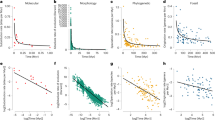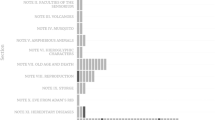Similar content being viewed by others
Main
First, my model considers genetic divergence of allopatric populations, whereas the models developed in ref. 2 describe the evolutionary consequences of a secondary contact between populations that have already diverged: that is, they model reinforcement of reproductive isolation rather than its emergence. Second, Parker and Partridge2 use an evolutionarily stable strategy framework with a set of fixed evolutionary options, whereas I model continuous coevolution of the sexes, during which evolutionary options are continuously changing.
In spite of these differences and contrary to the claim of Tregenza et al., there is no contradiction in the predictions of both types of model. Parker and Partridge propose that mating conflict could be either a hindrance to isolation if ‘male-win’ scenarios prevail, or a facilitator if females tend to win — exactly as predicted by my model if coevolution is restricted. However, my model takes an additional step by considering the possibility of continuous coevolution of the sexes. In this case the prediction is that neither sex will win the sexual conflict, but rather that there will be a dynamic coevolutionary compromise.
Tregenza et al. question the generality of my model's assumption that females have an intermediate optimum mating rate, as well as the specific (quadratic) function I used to model the relation between a female's fitness and her mating rate: in fact, the model is well supported by insect3 and other data4,5, and the idea that excessive mating rates are bad for females is the essence of sexual conflict.
Inadequate mating rates are also detrimental6. Thus, with sexual conflict the optimum mating rate must be intermediate. As for the shape of the relation between female mating costs and mating rate, more data are indeed necessary. However, I do not anticipate that using functions more complicated than a quadratic one will affect my main conclusions1.
Tregenza et al. suggest that, in most species, males will rapidly identify and attempt to mate only with those females with whom they are compatible, thus reducing the potential for sexual conflict to promote divergence. But even if the necessary ‘indicators’ of female compatibility should be readily available and the males smart enough to exploit them, in a polymorphic population different females will experience a variable number of matings. This will induce fitness differences and initiate runaway coevolution, resulting in genetic divergence of isolated populations. Although the model does not describe all the specific processes involved in sexual conflict, other weaknesses are not yet apparent.
References
Gavrilets, S. Nature 403, 886–889 ( 2000).
Parker, G. A. & Partridge, L. Phil. Trans. R. Soc. Lond. B 353, 261–274 (1998).
Arnqvist, G. & Nilson, T. Anim. Behav. (in the press).
Fowler, K. & Partridge, L. Nature 338, 760–761 (1989).
Gems, D. & Riddle, D. L. Nature 379, 723–725 (1996).
Jennions, M. D. & Petrie, M. Biol. Rev. 75, 21–64 (2000).
Author information
Authors and Affiliations
Rights and permissions
About this article
Cite this article
Gavrilets, S. reply: Sexual conflict and speciation. Nature 407, 150 (2000). https://doi.org/10.1038/35025140
Issue Date:
DOI: https://doi.org/10.1038/35025140
Comments
By submitting a comment you agree to abide by our Terms and Community Guidelines. If you find something abusive or that does not comply with our terms or guidelines please flag it as inappropriate.



